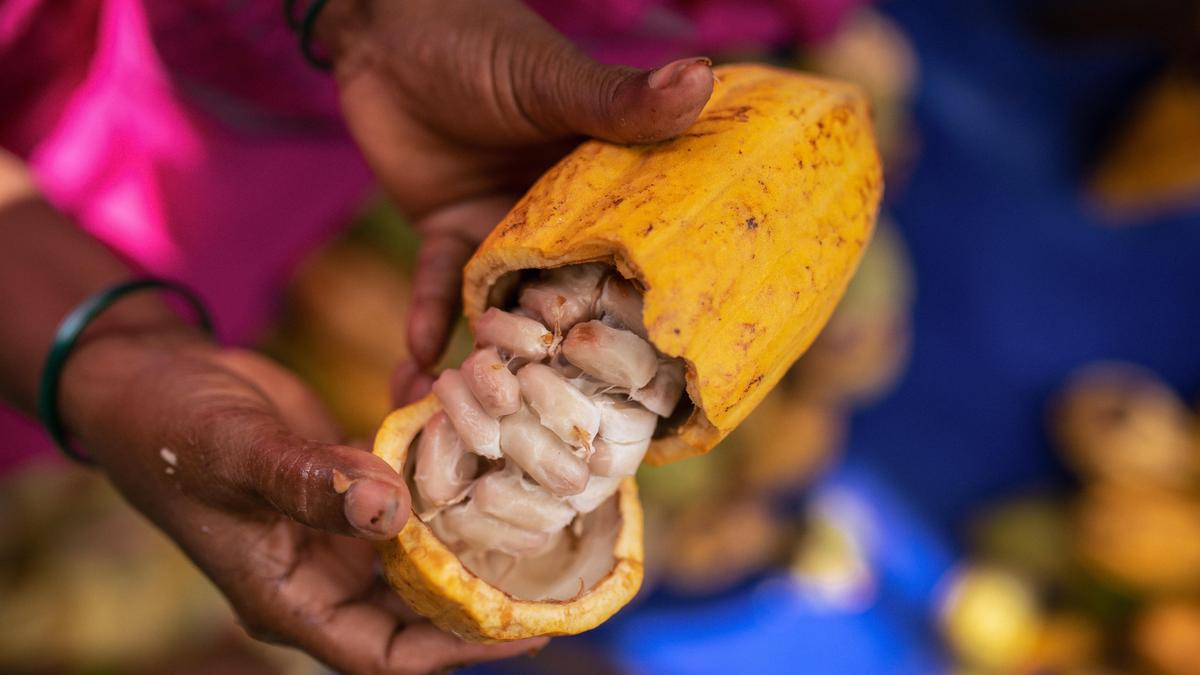
The big chocolate meltdown | Why 2024 cocoa prices are driving people nuts
The Hindu
As failed cacao crops and production shortfall push prices globally, it could mean shrinking chocolate bars and more non-chocolate flavours. Meanwhile, can quality craft chocolate from India step up to meet the demand?
At Miam Pâtisserie in Delhi, chef-founder Bani Nanda deftly glazes a Belgian chocolate cake. Her skill is impeccable, yet her distress is apparent — and the sweltering heat outside has little to do with it. Around 60% of the pâtisserie’s menu is chocolate-based; they get close to 60 chocolate cake orders on average a day, and their other chocolate desserts are perennial bestsellers. Even during mango or strawberry season, roughly 12-15 kg of chocolate go into their creations daily, and much of that is sourced from imported brands such as Callebaut.
“The soaring cocoa prices globally have meant a massive hike, 110% to 200% in some cases, in the prices of our primary ingredient — chocolate,” Nanda says. “We’ve already increased the prices of all our chocolate items by 5%-7%, from cakes down to a macaron. We’re trying to hike it slowly so as to not shock the customer, but our focus now is to start experimenting with more non-chocolate flavours.”
The price of cacao beans, the primary raw material for chocolate, skyrocketed to a record $12,000 a tonne in April, owing to extreme crop shortages and dangerously low liquidity on the commodities market. A combination of factors are at play. In Ghana and the Ivory Coast, the West African nations that produce the major share of the world’s cocoa beans, a bad harvest season has been brought on by El Niño weather conditions, black pod disease and ageing cacao trees. Additionally, historically inequitable market practices with big chocolate corporations pocketing the bulk of the profit, have left farmers with critically low incomes to replant new trees or implement disease prevention measures. In fact, the global chocolate crisis is such that top trader Pierre Andurand has forecast cocoa futures to climb as high as $20,000 this year, while a UN Trade & Development report states that the International Cocoa Organization is expecting a global shortfall of 3,74,000 tonnes for 2023-24 as compared to 74,000 tonnes last season.
In India, importers and suppliers of cocoa and chocolate brands such as Valrhona, Callebaut, Van Houten and others are also facing the fallout of the war raging in West Asia. “We import cargo by sea and with the crisis in the Red Sea, all cargo prices have shot up by 20%-30%. On top of that, the rupee has weakened by 10%-12% in the last six months, which has also made an impact since we buy in euros and dollars,” says Dhruv Sanghvi, senior manager at Delta Nutritives Pvt. Ltd., the prime suppliers of Callebaut and Cacao Barry in the country. According to him, the prices of these products have already shot up by 50% and are expected to increase to 100% plus by October. “There’s a lot of volatility in the cocoa price index, and even if the prices go down today, it’ll take five to six months for that to reflect in India.”
For the time being, suppliers like Delta have enough stock to last another six to eight months, so there may not be an apparent shortage of chocolate in the market yet. But for professionals like Nanda, who deal with cocoa and chocolate daily at higher price points, the price surge is dealing a heavy blow already.
Home baker Ipsa Sambhi was excited to embark on a new journey with her brand La Croute. The self-taught baker who has been delivering homemade pies since the lockdown, is slated to open her first café in leafy South Delhi soon. Her happiness though is mired with concern now. “I not only make five to six desserts with chocolate, but also use it in savoury sauces. Every day, I use around 2-5 kg of white, milk and dark chocolate, and the price hike is impacting my cost of production,” says Sambhi. “I do not intend to remove chocolate from my menu entirely, but I definitely have to keep it to just a couple of signature items for now. Once the cafe launches, I may have to increase the prices of my chocolate items, reduce portion sizes, and negotiate with suppliers for better deals.”
In Chennai, Ricky’s Cookies has made quite a name for itself in the past five years as an artisanal cookie brand. Almost 80% of their menu features chocolate in some form, including cocoa powder, cocoa nibs and cocoa butter, sourced from the likes of Valrhona and Callebaut, and Indian craft chocolate brands such as Paul and Mike, Mason & Co and Rakkaudella. “The prices of all these ingredients have gone up significantly. In fact, chocolate contains sugar and other ingredients, so the price hike isn’t as much in comparison as it is for cocoa powder or nibs that contain pure cocoa,” says chef Karthikeyan Jagannathan, who’s worked at renowned establishments like Alain Passard’s L’Arpège in Paris, as well as Avartana and Prego in India.











